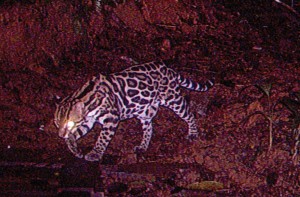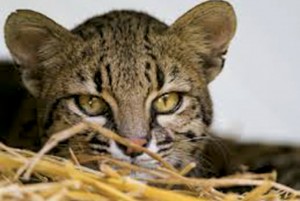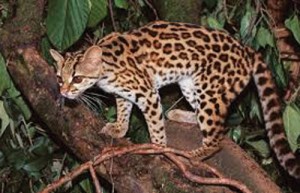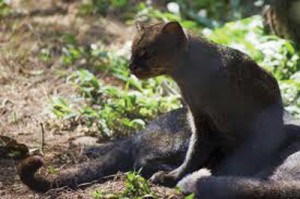Fat-Handed Cats: The return of the Ocelot

By Jack Ewing
The sleek, spotted cat rested with her chest and thick front paws on the log, her eyes peering over the top, waiting patiently for a spiny rat or some other small rodent to scurry along the other side. She had been there since moon rise, but so far no prey had ventured past. An uneasy feeling enveloped her body like a mist that penetrated to the very core of her being. She waited and watched. A faint sound reached her ears, and she became aware of the source of the unpleasant feeling: dogs, their distant howls drifting on the cool night breeze. The unwelcome wail was not new to her ears; it signified the most fearful thing in her environment. The thought of climbing a tree briefly flickered across her mind, but if the dogs caught her scent and found the tree, she would be trapped, an easy target for the humans that always come with the dogs. The other choice was to put distance between herself and the howling dogs, but the forest wasn’t that big, and she could only run so far. The female ocelot decided to wait and listen.

Maybe the feared canines would go a different direction. She crouched down as if to make herself smaller. But the sound kept coming closer, and the moment arrived that she had to make a move. The beautiful spotted feline sprinted through the forest keeping well to one side of the approaching dogs’ path. The terrain was familiar and she moved quickly and easily, making a wide circle around the oncoming dogs. She crossed their path well behind the excited howls, the area still strong with the dreaded scent. She headed for the stream and the one tree that meant safety. Crossing the swift current she came to the giant fig, with the buttress roots on one side reaching to the water’s edge. She climbed the trunk to an opening far above the ground, crawled into the hollow core, laid down on a ledge, and remained still, waiting, listening. After a time the baying of the dogs turned to a frenzy. They had probably cornered a paca in its cave. The sleek, spotted, female ocelot relaxed; she was safe until another day. Crouched in her hiding place, vivid memories flowed through her mind of another night long ago when her mother had hidden her and her brother in another hollow fig in a distant forest, and had then run away from the hiding place, intentionally leading the dogs astray. She remembered the three loud bangs that had reached her ears, the bangs that only came from humans. Her mother never returned. The following day she and her brother had ventured down from the tree and into the forest. They were old enough to make it on their own, but life wasn’t easy. They had stayed together for a short time, and then each had gone its own way.

Of the six species of wild cats in Costa Rica only the jaguar and puma are larger than the ocelot. The jaguarundi, margay cat and oncilla are all smaller. One biologist described the oncilla as the size of a small house cat, the margay and the jaguarundi the size of a large house cat, and the ocelot the size of a medium dog. A large one will weigh 14 kilograms (31 lbs.) with a head and body length of 90 centimeters (34.9 inches) and a tail length of 40 centimeters (15.7 inches.) The tail is relatively short in comparison with the head and body. In fact it is slightly shorter than the back leg. An ocelot track can measure as much as 7 centimeters (2.8 inches) across on the front feet and 5 centimeters (2 inches) on the back.
The name “ocelot” is derived from the Náhuatl (Central American Indian language) word océlotl which refers to the same cat. It appears often in pre Columbian art and lore and was an important totem in some indigenous cultures. For example, Aztec priests who performed human sacrifices always wore a cloak made of ocelot skins during the ritual.
There is often confusion between ocelots and jaguars in the folklore because in some cultures the word tigre refers to one of the spotted cats and in other cultures to the other. Also, in some places the name ocelot refers to the jaguar.

In the local Borucan Indian language the cat is called Cvon Kuas. In Costa Rica the ocelot is usually called manigordo or “fat hand” because of its exceptionally thick front paws. Ocelots are agile climbers and often sleep in trees, but most of their waking hours are spent on the ground. Unlike most cats ocelots don’t stalk their prey, rather they wait and watch or wander stealthily around and kill what they come across. Though they hunt mostly small rodents, they have been known to kill animals as large as peccary. They will occasionally kill birds, which they pluck, before eating.
Hunting and Habitat
In 1973, when my cowboy, Tonio, killed an ocelot, all of the lowlands of Hacienda Barú, 160 hectares (395 acres,) had been deforested and planted to cattle pasture. About 170 hectares (420 acres) of primary forest remained in the highlands. A few of the neighboring properties still had isolated parcels of jungle, but many had been totally denuded of trees. Hunting was rampant, and every year there was less forest and fewer animals to hunt. Most hunters used dogs, and, as we have seen, hunting dogs could easily pursue and tree an ocelot. Once the cat was treed it was an easy target for hunters’ rifles. On top of all of this ocelots had the un-endearing habit of sneaking into farm yards and killing chickens. Few people saw them as the magnificent spotted cats that they are. In fact, most considered them to be pests that should be shot on sight. With odds like that against them it is no wonder that the ocelot population dipped very near to zero. It is possible that the ocelot that Tonio killed was the last one on Hacienda Barú at that time, or very nearly so. But that was almost 40 years ago, and many things have changed.

In 1979 we started restoring habitat at Hacienda Barú. Little by little over the next 20 years 160 hectares (395 acres) of pasture land was turned over to Mother Nature who returned it to its natural state. 1985 marked the peak of deforestation in the area that comprises the Path of the Tapir Biological Corridor. From that date forward every year has seen an increase in forest cover. Another important consideration is that ecological tourism has become an important source of income in the area, and many people realize how important it is to protect the rainforest and wildlife which attracts so many visitors to the region. Another important factor in the ocelot’s recovery has been the creation of a number of protected nature reserves, both formal, like National Wildlife Refuges, and informal privately owned nature reserves. Many of the owners of these reserves hire guards to protect them. Hunters with dogs are easy for the guards to locate because of their excited howls. Some guards capture the dogs and turn them over to the wildlife department of the environmental ministry, MINAET, and others shoot them on sight. As a result many poachers have quit hunting with dogs and now use traps instead. The traps are designed to catch peccary and pacas, but not ocelots. This has contributed considerably to the recovery of the beautiful, spotted cats.
Ocelot Populations
We will never know if the ocelot that Tonio killed in 1973 was the last one in the jungle at that time, but there were no more sightings at Hacienda Barú for 18 years. In 1991 an ornithologist was sitting on a log watching and listening for birds in the primary forest of Hacienda Barú when a mature male ocelot came strolling past totally unaware of the human presence. The following year Diane Ewing was returning from a middle-of-the-night trip to the hospital with a sick employee when she spotted an ocelot along the road in the Hacienda Barú forest near the Barú River. It had some sort of prey, which she couldn’t identify, in its mouth. A year later one of the park rangers saw an ocelot near one of the self-guided trails in the lowlands of Hacienda Barú. Since that time there have been one or two sightings every year by guides, tourists or park rangers. I have captured many videos of them with several trail cameras placed at different locations on Hacienda Baru. Recently a friend and neighbor, Cheryl Margoluis, was out on an early morning run when she came face to face with a female ocelot and two kittens. Obviously ocelot populations have recovered significantly over the last 40 years and there are now quite a few of them on Hacienda Barú and within the Path of the Tapir Biological Corridor.
Ocelots defend a fairly large territory, and even in a protected area the size of Hacienda Baru and the neighboring private nature reserves – a little over 500 hectares (1236 acres) altogether – there aren’t likely to be more than three males and seven to ten females. In addition to the low population density it is also important to take into consideration that ocelots are mostly active at night and are very secretive animals. All of these factors mean that even when populations levels are high, sightings are few and far between.
On Saturday, April 28, 2012 a couple of wildlife inspectors from MINAET came to Hacienda Barú with a cage in the back of their pick-up. In the cage was a young, adult, male ocelot. The cat had been killing chickens at a farm near the village of San Juan de Dios. One night the owner of the farm managed to lock the culprit inside the chicken house. Rather than kill it, as would have happened 20 or 30 years ago, the owner called MINAET. The inspectors managed to get a noose around the ocelot’s neck and maneuver it into the cage. It acquired a few bumps and scrapes in the process.
First they took it to the animal clinic in Uvita. My wife Diane happened to be there at the time, and helped distract the cat while Dr. Rivera dabbed a little antiseptic on the abrasions with a long swab. He checked it over and told the inspectors that the cat appeared to be healthy and in good condition and that in his opinion there should be no problem with releasing it in a suitable habitat. Then they brought it to Hacienda Barú. With the help of several of the workers at Hacienda Barú and the park rangers, they mounted the cage on a couple of bamboo poles and carried it about a kilometer (0.62 miles) up into the rainforest on the upper slopes of the refuge. There the ocelot was returned to its native habitat. Hopefully it found a territory and settled into a normal life of hunting small rodents and other available prey. If it returns to its old habit of killing chickens, the next farmer may not be so forgiving.
Jack Ewing was born and educated in Colorado. In 1970 he and his wife Diane moved to the jungles of Costa Rica where they raised two children, Natalie and Chris. A newfound fascination with the rainforest was responsible for his transformation from cattle rancher into environmentalist and naturalist. His many years of living in the rainforest have rendered a multitude of personal experiences, many of which are recounted in his published collection of essays, Monkeys are Made of Chocolate. Jack and Diane live on and manage the Hacienda Barú National Wildlife Refuge, a well-known ecotourism destination on the southwest coast of Costa Rica.
